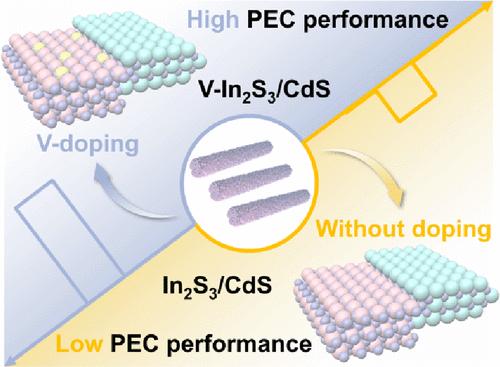Modulating Built-In Electric Field Strength in an In2S3/CdS Heterojunction via Vanadium Doping for a Photoelectrochemical Immunoassay
IF 6.7
1区 化学
Q1 CHEMISTRY, ANALYTICAL
引用次数: 0
Abstract
Constructing a built-in electric field (BIEF) in heterojunctions is regarded as an effective strategy for improving photoelectrochemical (PEC) performance since it acts as a key factor in accelerating charge transfer and separation. Herein, a PEC immunosensor with excellent target responsiveness was presented based on vanadium-doped indium sulfide/cadmium sulfide (V–In2S3/CdS) heterojunctions with a giant BIEF and excellent peroxidase-like (POD-like) activity. The BIEF strength of the heterojunction can be effectively modulated by V doping to facilitate rapid charge transfer and separation, resulting in an enhanced photocurrent. Notably, the POD-like activity of the V–In2S3/CdS heterojunction could effectively catalyze the decomposition of hydrogen peroxide (H2O2) to produce hydroxyl radicals (•OH). To achieve a sensitive PEC immunoassay, carcinoembryonic antigen (CEA) was specifically recognized by a sandwich-type immune reaction to generate H2O2. The generated H2O2 was catalytically decomposed by the V–In2S3/CdS heterojunction to produce highly oxidative •OH radicals that could trap photoelectrons, resulting in a sharp quenching of the initial photocurrent signal. Leveraging the distinctive photocurrent variation, a highly sensitive PEC sensing platform was designed for CEA detection, exhibiting a linear detection range from 0.02 to 50 ng/mL and a low detection limit of 5.8 pg/mL. This work sets the stage for the application of the BIEF as an advanced signal modulation strategy for high-performance PEC immunoassays.

用钒掺杂调制In2S3/CdS异质结内建电场强度用于光电免疫分析
在异质结中构建内置电场(BIEF)是加速电荷转移和分离的关键因素,被认为是提高光电化学(PEC)性能的有效策略。本文提出了一种基于钒掺杂硫化铟/硫化镉(V-In2S3 /CdS)异质结的PEC免疫传感器,该异质结具有巨大的BIEF和优异的过氧化物酶样(pod样)活性。V掺杂可以有效地调节异质结的BIEF强度,促进快速的电荷转移和分离,从而增强光电流。值得注意的是,V-In2S3 /CdS异质结具有pod样活性,可以有效催化过氧化氢(H2O2)分解生成羟基自由基(•OH)。为了实现敏感的PEC免疫分析,癌胚抗原(CEA)通过三明治型免疫反应特异性识别产生H2O2。生成的H2O2被V-In2S3 /CdS异质结催化分解,生成高度氧化的•OH自由基,可以捕获光电子,导致初始光电流信号急剧猝灭。利用独特的光电流变化,设计了一个用于CEA检测的高灵敏度PEC传感平台,其线性检测范围为0.02 ~ 50 ng/mL,低检测限为5.8 pg/mL。这项工作为BIEF作为高性能PEC免疫测定的先进信号调制策略的应用奠定了基础。
本文章由计算机程序翻译,如有差异,请以英文原文为准。
求助全文
约1分钟内获得全文
求助全文
来源期刊

Analytical Chemistry
化学-分析化学
CiteScore
12.10
自引率
12.20%
发文量
1949
审稿时长
1.4 months
期刊介绍:
Analytical Chemistry, a peer-reviewed research journal, focuses on disseminating new and original knowledge across all branches of analytical chemistry. Fundamental articles may explore general principles of chemical measurement science and need not directly address existing or potential analytical methodology. They can be entirely theoretical or report experimental results. Contributions may cover various phases of analytical operations, including sampling, bioanalysis, electrochemistry, mass spectrometry, microscale and nanoscale systems, environmental analysis, separations, spectroscopy, chemical reactions and selectivity, instrumentation, imaging, surface analysis, and data processing. Papers discussing known analytical methods should present a significant, original application of the method, a notable improvement, or results on an important analyte.
 求助内容:
求助内容: 应助结果提醒方式:
应助结果提醒方式:


